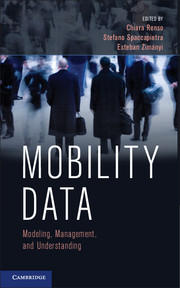Book contents
- Frontmatter
- Contents
- List of Contributors
- Preface
- Acknowledgments
- PART I MOBILITY DATA MODELING AND REPRESENTATION
- 1 Trajectories and Their Representations
- 2 Trajectory Collection and Reconstruction
- 3 Trajectory Databases
- 4 Trajectory Data Warehouses
- 5 Mobility and Uncertainty
- PART II MOBILITY DATA UNDERSTANDING
- PART III MOBILITY APPLICATIONS
- PART IV FUTURE CHALLENGES AND CONCLUSIONS
- Bibliography
- Glossary
- Author Index
- Subject Index
- Plate section
1 - Trajectories and Their Representations
from PART I - MOBILITY DATA MODELING AND REPRESENTATION
Published online by Cambridge University Press: 05 October 2013
- Frontmatter
- Contents
- List of Contributors
- Preface
- Acknowledgments
- PART I MOBILITY DATA MODELING AND REPRESENTATION
- 1 Trajectories and Their Representations
- 2 Trajectory Collection and Reconstruction
- 3 Trajectory Databases
- 4 Trajectory Data Warehouses
- 5 Mobility and Uncertainty
- PART II MOBILITY DATA UNDERSTANDING
- PART III MOBILITY APPLICATIONS
- PART IV FUTURE CHALLENGES AND CONCLUSIONS
- Bibliography
- Glossary
- Author Index
- Subject Index
- Plate section
Summary
Introduction
For a long time, applications have been using data about the positions of the moving objects they are interested in. For example, city planning applications, in particular in the transportation and traffic management domains, have been observing and monitoring traffic flows to capture their characteristics, namely their importance and localization, with the aim to build better models for traffic regulation and to identify solutions for future development of the existing road network. Sociologists have also been examining the movement of cars equipped with GPS, focusing on individual cars rather than traffic flows, to understand the habits of their drivers. In the logistics domain, applications have been monitoring the localization of the parcels during their transportation from their source locations to their destinations. These applications use the data both to be able to locate a parcel at any time and to optimize the performance of the transportation and distribution strategy. Similar concerns rule the management of data tracking airline passengers and their luggage. Ecologists have been observing animals and, whenever possible, tracking them via transmitters and satellites, mainly to understand animals' individual and group behaviors. Nowadays many enterprises are looking to extract information about their potential consumers out of the tracks left by their smartphones, electronic tablets, or access to social networks such as Flickr and Foursquare that record the geographic position of their users.
Traditionally, data about movement have been captured using static facilities, for example, sensors producing traffic flow measures or detecting an animal's presence. Data acquisition facilities changed drastically with the availability of embedded positioning devices (e.g., GPS).
- Type
- Chapter
- Information
- Mobility DataModeling, Management, and Understanding, pp. 3 - 22Publisher: Cambridge University PressPrint publication year: 2013
- 5
- Cited by



